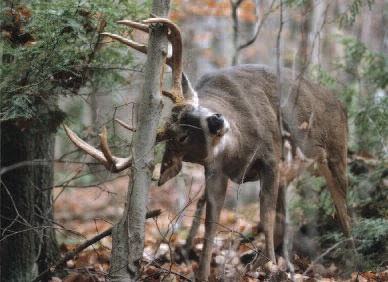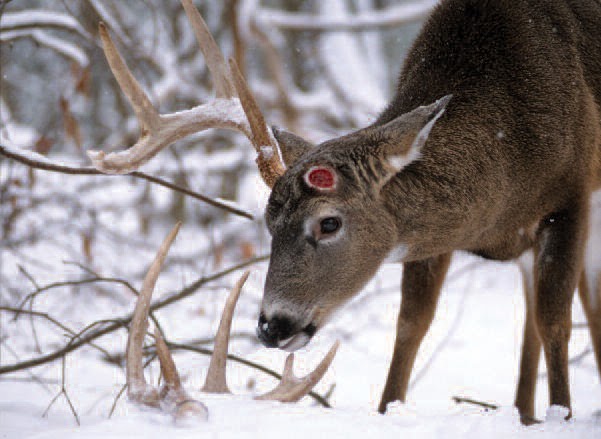By Charles J. Alsheimer
This series of photos documents the antler growth and behavior of a buck I photographed through 12 years. The buck lived on an incredible piece of property in the Northeast that was off limits to hunting. Aside from protection from hunters, he had a normal life, complete with many challenges from Mother Nature. His home range featured a substantial predator population and received significant snowfall during winter. Throughout my career, I’ve imprinted many whitetails on the sound of corn rattling in a plastic can. This buck was one such animal. Unlike many of the deer on this property, the buck had a gentle disposition and never exhibited any aggressiveness toward me, even during the fullblown rut. Consequently, I could follow him and document some incredible behavior through several years. As the buck aged, I was even able to feed him out of my hand.
Interestingly, this buck was only a three-inch spike as a yearling. His largest set of antlers was grown in his sixth year and measured 169 Boone & Crockett. When the buck reached four, he began casting his antlers on nearly the same day each year. This let me know when I needed to be present to capture these rare antler-casting images. Only once did the buck shed both antlers at the same time. Normally, he would cast one antler about Feb. 25 and then carry the other for a day or two. This sequence was taken when the buck was seven. It covers a year in his life — from antler cast to antler cast. During the year these photos were taken, his rack scored 165 Boone and Crockett.
WINTER
The sequence begins in the dead of winter, a time the Native Americans called the “Hunger Moon.” In the area this buck lived, it’s not uncommon for temperatures to hover between zero and the low teens for days. Such bitter cold is the reason the natural world comes to a halt in the North during January and February. During the year this sequence was photographed, this buck was in the prime of his life. He was the dominant buck in the area, and with the exception of occasional interaction with the other bucks in his bachelor group, he kept to himself during winter. About 90 percent of his time was spent bedded, with his daytime feeding usually occurring at midday and during the last hour of daylight. In spite of snow depths in excess of a foot for most of the winter, he appeared to come through March in very good shape.
SPRING
As with most mature bucks I’ve observed through the years, this buck began growing his antlers about March 20. His antler growth was minimal during the first month. However, when spring green-up arrived and the days became longer, his antler growth accelerated. When winter passed its torch to spring, the big buck’s changing fur coat made him look very unhealthy. Like the other deer in the area, he began losing clumps of fur around May 1. By the beginning of June, his summer coat was fully grown, and he took on a very sleek look. When June bursts on to the scene, black flies and other insects can be a real nuisance for wildlife. Consequently, the latter stages of spring can be very stressful for Northern whitetails. This buck attempted to flee the insects’ assault by bedding in high grass and staying close to water sources. As a result, he was often difficult to locate later in spring.
SUMMER
When July arrived, the buck was beginning to show his antler potential. Though they would eventually be much longer, all of his antler points were visible by mid-July. He also became more predictable as the summer progressed, and I often photographed him in a couple of clover fields at either end of the day. He would feed alone occasionally, but it was more common for him to stay in a bachelor group of four bucks, of which he was the largest. By Aug. 1, his antlers were full grown and were as big as they would be at any point during the year. Around mid-August, they began to shrink in size, and the velvet on them changed from a dark brown to a grayish tone, which is typical when the antler calcification process begins. I photographed the buck just before dark Sept. 4, and it didn’t appear that his antlers were ready to peel. However, when I located him the next day, he had stripped almost all of the velvet from his rack.
AUTUMN
As autumn progressed, the big 9-pointer revealed his dominance to the bucks in the area at every opportunity. He would do this by staring down other bucks, dropping his ears, bristling his hair and, in a few cases, fighting. Because he was the largest buck around, most of the others never challenged him to a fight. During September and October, the buck didn’t move a great deal during daylight, preferring to feed at either end of the day. By the latter part of September, he no longer spent time with his summer bachelor group, opting instead to keep to himself. Frequently, I photographed him making rubs and scrapes. By the end of October, he was in peak condition and laden with fat. He also was becoming increasingly active. When the air temperature dropped below 40 degrees, I knew he would be up and moving around his territory. During one two-hour period, I photographed him making 10 scrapes and two rubs. He had turned into a rutting machine. By the time the rutting moon shown full Nov. 4, he looked like he was ready to explode. During the next week, he challenged every buck and chased every doe he encountered. He also vocalized a great deal. It was obvious from his aggressive behavior that his testosterone had peaked. On Nov. 18, the weather turned cold, and the season’s first snowfall arrived. Bucks were going ballistic, including the big 9-pointer. He had found a doe near estrous and stuck close to her side. Throughout the day, three smaller bucks stayed close enough to cause quite a commotion. Their presence highly irritated the big buck. He trashed small trees, snort-wheezed and tried to run them off.
Because they knew the doe was nearing estrous they hung around in spite of the big 9-pointer’s challenges. This scenario continued for two days. On Nov. 19, I photographed the big buck breeding the doe four times during the day. By midday on the 20th, the doe obviously had cycled out of estrous and no longer “smelled right,” as the buck left her to look for another breeding opportunity.
WINTER
By early December, the buck appeared to have lost a considerable amount of weight from the rut. He was no longer looking for does. Instead, he spent much of his time bedding and feeding. His winter routine had returned. Because this buck lived on excellent range and had access to ample food, he always dropped his antlers within a day or two of the previous year beginning when he was four years old. Consequently, he shed one antler Feb. 23, and two days later the other was cast. His yearly cycle was complete.











